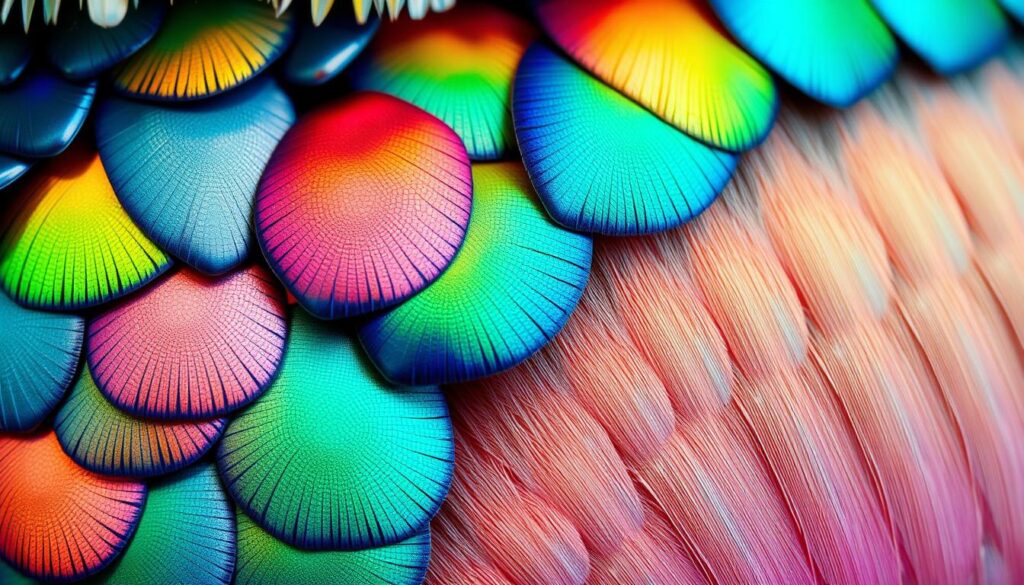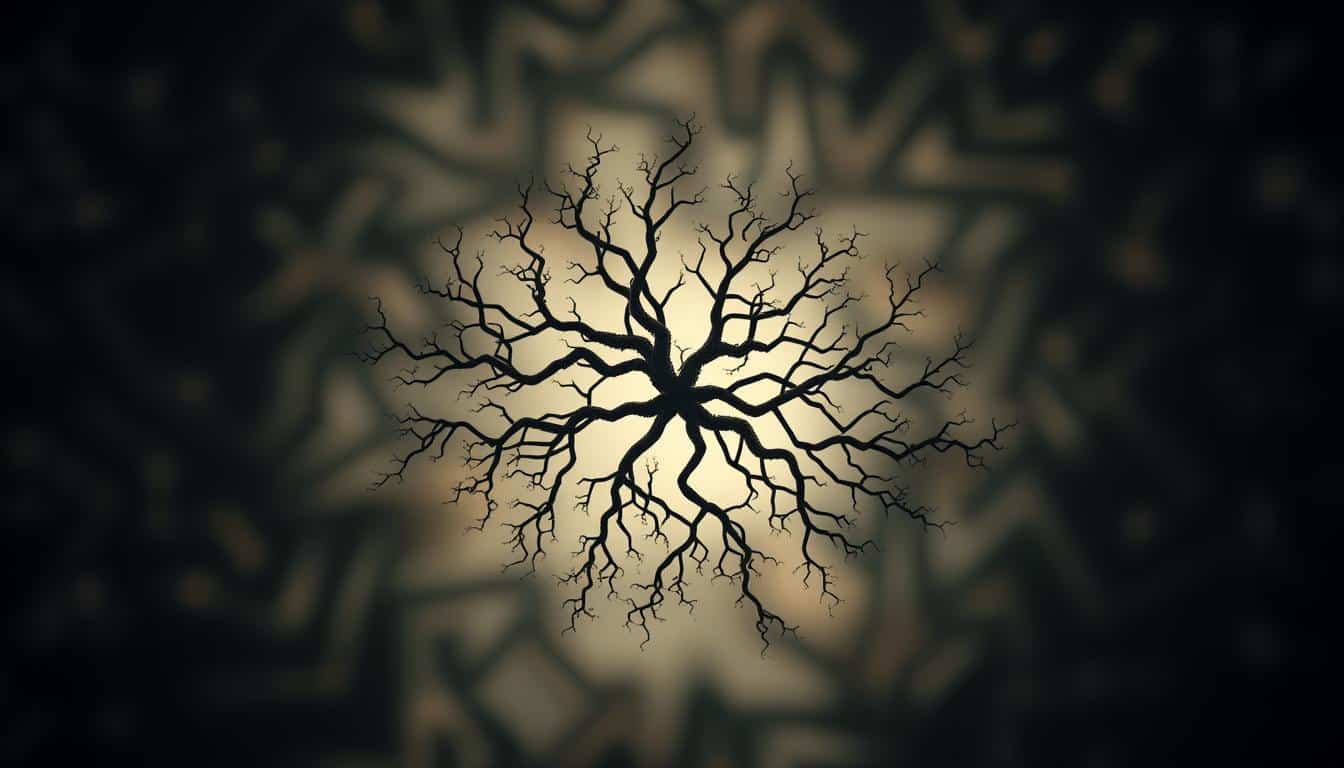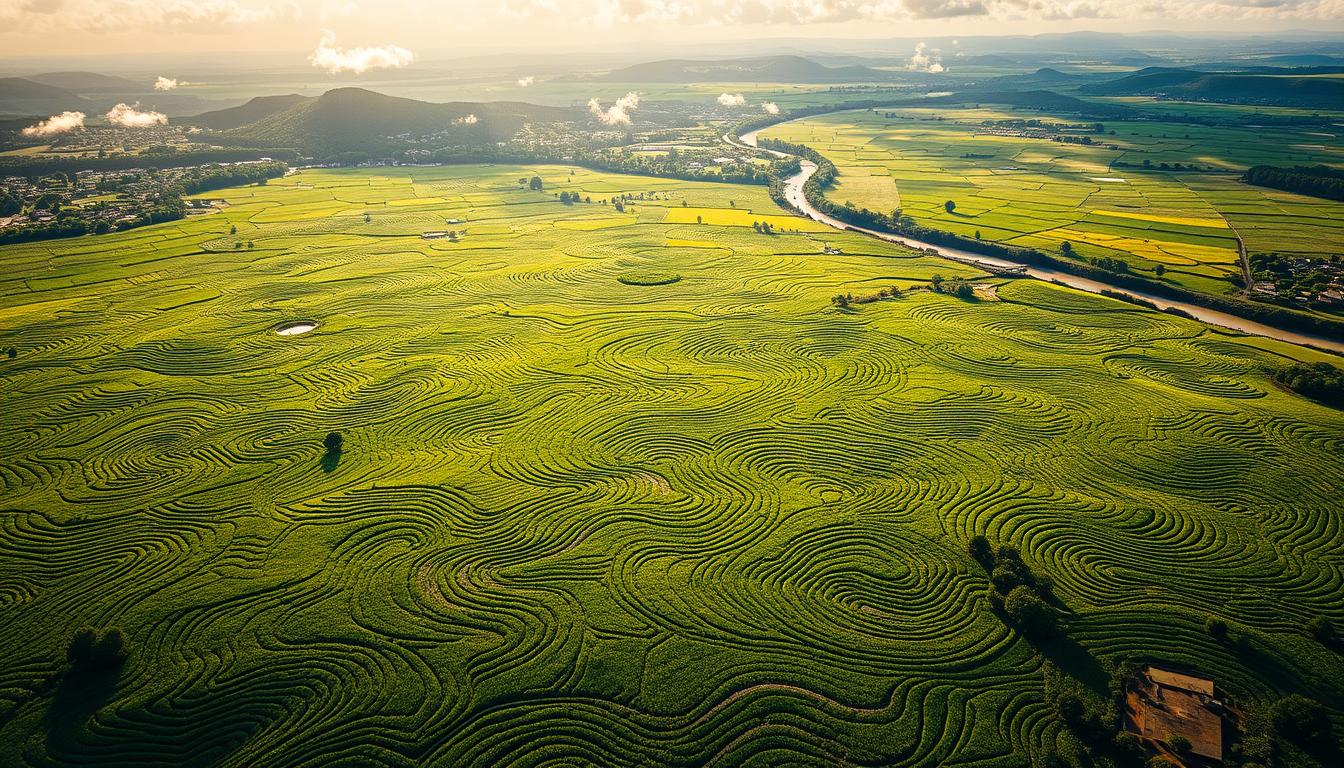Fractal patterns are a major part of wildlife biology. They show a world where self-similarity and complexity join. These patterns aren’t just for math fans. They highlight the beauty and practicality of animal colors.
By exploring fractal geometry, we learn about ecological interactions and how species communicate and survive. This journey improves our grasp of biology. It highlights the importance of fractal patterns in understanding nature.
The Importance of Color Patterns in Wildlife
Color patterns are very important in wildlife, affecting how animals survive and reproduce. They’re not just for looks; they play a big role in natural and sexual selection. Bright colors can show how healthy and strong an animal is to potential mates, helping it have more babies. Also, being able to blend in with surroundings lets animals hide from predators and hunt better.
Color patterns are key for animals to talk to each other. They use colors to warn about danger or to mark their area. A mix of genes and body functions creates the variety of animal colors we see. Knowing how these work helps us study how color signals good health in animal groups.
Science is getting better at understanding animal color patterns. Researchers look closely at color to learn more than just shade and brightness. This deep study helps us learn about how animals evolve and interact with their environment.

Understanding Fractals: A Mathematical Perspective
Fractals are a fascinating part of math, known for repeating patterns. They differ from usual shapes because they keep their form at different sizes. This shows how fractal geometry helps us understand complex systems in nature.
When we model fractals mathematically, we get tools for measuring nature’s wonders. The key measure, fractal dimension (FD), helps quantify the complexity of patterns. From the edges of coastlines to the branching of trees, fractals show nature’s deep patterns of organization and growth.
This math field is crucial for studies in wildlife biology too. It helps scientists explore the complex patterns in animal colors and other traits. Through fractal analysis, we uncover the deep connections between math and the natural world.
Fractal Patterns in Wildlife Biology and Ecology
Fractal patterns are really important in wildlife biology. They help animals share crucial information. We see these patterns in how animals look differently from one another. They’re not just nice to look at but also help animals talk to each other. Knowing about these patterns helps us understand how animals interact and how ecosystems work.
The Role of Color Patterns in Animal Communication
Animals use color patterns to show how healthy they are and if they’re ready to mate. For example, the red-legged partridge has special color patterns. These patterns are not just for looks. They also send signs during social times. The complexity of these patterns can show off an animal’s good genes. This is useful when choosing a mate.
How Fractals Help in Measuring Trait Variability
Fractal patterns are more than just colors we see. Scientists use them to understand differences in traits among animal groups. Even small changes in how animals look can affect their survival and mating. By looking closely at these changes, scientists learn more about how animals live together. This helps link the differences we see to the overall wellness of environments.
Animal Coloration: Beyond Simple Traits
Animal coloration is more than just skin deep. It involves complex interactions that affect animals in their environments. Patterns like those seen in various species play a key role, making the study of these traits complicated. One example is the red-legged partridge, with its unique plumage that shows how complex animal colors can be.
The Complexity of Heterogeneous Patterns
Heterogeneous patterns in animals are not just random. They act as signals that can help an animal survive or find a mate. These patterns go beyond simple colors or shapes. They can tell us about the animal’s health, genes, and how well it can adapt to its surroundings.
A Study of the Red-Legged Partridge
The red-legged partridge helps scientists understand how color patterns work. Its feathers show a mix of colors and unique designs, like its noticeable black bib. Studies suggest these patterns may link to the bird’s health, how well it fights off sickness, and its ability to adapt.
By analyzing these patterns, researchers get closer to uncovering the secrets of animal coloration. This approach highlights the importance of seeing beyond the surface in wildlife studies.
Fractal Geometry as a Tool in Ecology
Fractal geometry is a useful tool in ecology, helping to grasp the complexity and variability of life. It lets scientists measure complex patterns hard to analyze with old methods. By using fractal ideas, they can explore how living things relate to their surroundings.
The use of fractal geometry aids ecological studies in many ways. It makes complex data easier to understand, helping scientists to:
- Identify patterns in species distribution and behavior.
- Predict ecological interactions based on structural traits.
- Assess biodiversity and resilience in ecosystems.
Exploring deeper into conservation and how creatures behave, fractal geometry offers a detailed look into biological traits. This approach does not just improve research quality. It also helps us better understand the dynamics of ecosystems.
How Fractals Capture Biological Information
Fractal dimensions are very important for understanding the health and biological quality of organisms. By analyzing fractals, scientists can see complex patterns. These patterns are linked to traits like body health and how well the immune system works. So, the fractal dimension is not just about looks. It helps us understand the deep biological processes that affect an animal’s health.
Fractal Dimension (FD) and Individual Quality
The fractal dimension is a good way to tell if an organism is healthy. When an organism has higher fractal dimensions in its physical traits, it usually means it is healthier. This shows that fractal traits can tell us how complicated and efficient an organism’s body structures are. So, we can measure how well an individual is doing.
Assessing Immune Response Through Fractal Analysis
Fractal analysis is useful for checking how good an immune response is. It uses methods such as the phytohaemagglutinin skin test. This test looks at how much swelling there is to judge immune function. Scientists can then match these findings with the fractal patterns they see in an organism. This connection between strong immune responses and certain fractal dimensions gives us more insights into animal health.
The Impact of Diet and Condition on Fractal Patterns
How an animal eats affects its body condition and fractal patterns. Nutrition is key in how animals show fractal traits. Lack of food changes their physical and biological features, including fractals in color patterns.
The red-legged partridge is a great example. Studies show less food during moult changes the bird’s bib’s fractal dimensions. This shows how health impacts the complexity of color patterns. It links an animal’s diet to its fractal look.
This knowledge improves our understanding of wildlife biology. It connects environment, food, and fractal signals in animals. This could open doors to study how animals adapt and show these changes.
Experimental Approaches to Studying Fractal Geometry
Studying fractal geometry in wildlife needs different experimental methods. These methods help scientists understand the complex patterns found in nature and their importance for survival. Key to this research is a strong experimental design. It helps explore how fractal patterns relate to the living world.
To see how food supply affects fractal patterns in animals, researchers limit their food. This method mixes ecological study with close observation. It shows how diet influences these intricate patterns across species.
Breeding studies are also crucial. They help uncover the genetic roots of fractal patterns by looking at traits over generations. These studies use precise measurements to focus on genetic impacts on fractal shapes.
These varied research methods help us learn more about fractal geometry in animals. They highlight its importance for survival and ongoing life. As scientists keep using new experimental designs, our knowledge of nature’s complexity will grow. This is key to understanding life’s intricacy.
The Future of Fractal Research in Wildlife Biology
Fractal research in wildlife biology is about to change big time. The goal is to better understand the complex colors in different animals and their ecological importance. With the help of tech like artificial intelligence, we can dive deeper into fractal studies. This means we can use them more in ecology and saving the environment.
By adding fractal geometry to biology, we can find new ways to look at biodiversity. Scientists think this will help a lot in making plans to protect nature. Working together across different fields, we can use fractals to learn more about the complex patterns in wildlife than ever before.
Conclusion
This article talks about how fractal patterns deeply affect wildlife biology and ecology. By studying nature’s detailed designs, we gain key insights into how animals behave, communicate, and stay healthy. Using fractal geometry helps scientists understand how animals’ physical features relate to their environment, improving our knowledge of biodiversity.
Looking into fractal patterns highlights how they impact individual animals and shows why we need more research in this field. As we link these mathematical ideas with life, we grow to appreciate nature’s beauty and complexity more. Looking ahead, wildlife biology will benefit from incorporating fractal geometry into ecological studies, keeping us at the forefront of new discoveries.



